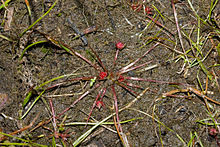Trithuria submersa
| Trithuria submersa | |
|---|---|

| |
| Complete flowering Trithuria submersa specimen | |
| Scientific classification | |
| Kingdom: | Plantae |
| Clade: | Tracheophytes |
| Clade: | Angiosperms |
| Order: | Nymphaeales |
| Family: | Hydatellaceae |
| Genus: | Trithuria |
| Species: | T. submersa
|
| Binomial name | |
| Trithuria submersa | |

| |
| Trithuria submersa is endemic to Australia[1] | |
| Synonyms[1] | |
|
Juncella submersa (Hook.f.) Hieron. | |
Trithuria submersa is a species of plant in the family Hydatellaceae endemic to the Australian states New South Wales, South Australia, Tasmania, Victoria, and Western Australia.[1]
Description
[edit]
Vegetative characteristics
[edit]It is a 8 cm tall, and 2-5 cm wide,[2] annual herb with glabrous, red, 15–40[3](–50)[4] mm long, and up to 1 mm wide leaves[3] and fibrous roots.[5] Individuals growing submerged in water are slender and green in colour.[2]
Generative characteristics
[edit]It is a monoecious species[6] with emergent, bisexual reproductive units ("flowers").[7] The several 2–3 mm wide reproductive units[5] consist of (5–)10–32(–40) mm long stalks,[4] (2–)4–8[8] ovate to lanceolate, 2–4 mm long bracts, 10–20(–35) carpels[5] with 3-6 stigmatic hairs,[9][2] and 2–4 central stamens with 2 mm long red filaments and purple anthers,[5] which are 0.6 mm long.[9] The three-ribbed,[5][9] obovoid, 0.5–0.8 mm long fruit[5] bears sculptured,[8] brown, 0.5 mm long, and 0.3 mm wide seeds.[9] It is a self-pollinating species.[7] Flowering and fruiting occurs from September to January.[10] Seed germination occurs in winter, once the seasonally dry habitat becomes wet.[11]
Cytology
[edit]The diploid chromosome count is 2n = 56.[12]
Distribution
[edit]It is endemic to the Australian states New South Wales, South Australia, Tasmania, Victoria, and Western Australia.[1]
Taxonomy
[edit]It was published by Joseph Dalton Hooker in 1858.[1] The lectotype was collected by R.C. Gunn in Macquarie River, Tasmania, Australia on the 6th of November 1845. It is the type species of its genus.[8] It is placed in Trithuria sect. Trithuria.[13][14]
Etymology
[edit]The specific epithet submersa, meaning "underwater", refers to the species aquatic habitat.[9]
Conservation
[edit]Under the Threatened Species Protection Act 1995, it is classified as rare.[15]
Ecology
[edit]It occurs in temporary pools, at the edge of streams, and seasonal swamps.[6]
References
[edit]- ^ a b c d e f "Trithuria submersa Hook.f." Plants of the World Online. Royal Botanic Gardens, Kew. Retrieved 12 November 2024.
- ^ a b c D.A.Cooke. Trithuria submersa, in (ed.), Flora of Australia. Australian Biological Resources Study, Department of Climate Change, Energy, the Environment and Water: Canberra. https://profiles.ala.org.au/opus/foa/profile/Trithuria%20submersa [Date Accessed: 13 November 2024]
- ^ a b Royal Botanic Gardens and Domain Trust, Sydney. (n.d.). Trithuria submersa Hook.f. PlantNET (the NSW Plant Information Network System). Retrieved November 12, 2024, from https://plantnet.rbgsyd.nsw.gov.au/cgi-bin/NSWfl.pl?page=nswfl&lvl=sp&name=Trithuria~submersa
- ^ a b Royal Botanic Gardens Victoria. (2014, January 25). Trithuria submersa Hook.f. VicFlora Flora of Victoria. Retrieved November 12, 2024, from https://vicflora.rbg.vic.gov.au/flora/taxon/4b0fcf12-f7e0-4caa-9529-50b0f77be40c
- ^ a b c d e f Duretto MF (2011) 1 Hydatellaceae, 2011:1. In MF Duretto (Ed.) Flora of Tasmania Online. 4 pp. (Tasmanian Herbarium, Tasmanian Museum & Art Gallery: Hobart). www.tmag.tas.gov.au/floratasmania
- ^ a b Western Australian Herbarium & Department of Biodiversity, Conservation and Attractions. (n.d.-c). Trithuria submersa Hook.f. Florabase—the Western Australian Flora. Retrieved November 12, 2024, from https://florabase.dbca.wa.gov.au/browse/profile/1141
- ^ a b Taylor, M. L., Macfarlane, T. D., & Williams, J. H. (2010). Reproductive ecology of the basal angiosperm Trithuria submersa (Hydatellaceae). Annals of Botany, 106(6), 909-920.
- ^ a b c Sokoloff, D. D., Remizowa, M. V., Macfarlane, T. D., & Rudall, P. J. (2008). Classification of the early‐divergent angiosperm family Hydatellaceae: One genus instead of two, four new species and sexual dimorphism in dioecious taxa. Taxon, 57(1), 179-200.
- ^ a b c d e Government of South Australia Department for Environment and Water & Botanic Gardens of South Australia. (n.d.). Trithuria submersa (Hydatellaceae). Seeds of South Australia. Retrieved November 12, 2024, from https://spapps.environment.sa.gov.au/SeedsOfSA/speciesinformation.html?rid=4619
- ^ Trithuria submersa Hook.f. (n.d.). Atlas of Living Australia. Retrieved November 12, 2024, from https://bie.ala.org.au/species/https://id.biodiversity.org.au/node/apni/7022449
- ^ Moschin, S., Nigris, S., Offer, E., Babolin, N., Chiappetta, A., Bruno, L., & Baldan, B. (2024). Reproductive development in Trithuria submersa (Hydatellaceae: Nymphaeales): the involvement of AGAMOUS-like genes. Planta, 260(5), 1-13.
- ^ Kynast, R. G., Joseph, J. A., Pellicer, J., Ramsay, M. M., & Rudall, P. J. (2014). Chromosome behavior at the base of the angiosperm radiation: Karyology of Trithuria submersa (Hydatellaceae, Nymphaeales). American Journal of Botany, 101(9), 1447–1455. http://www.jstor.org/stable/43826701
- ^ Sokoloff, D. D., Remizowa, M. V., Macfarlane, T. D., Conran, J. G., Yadav, S. R., & Rudall, P. J. (2013). Comparative fruit structure in Hydatellaceae (Nymphaeales) reveals specialized pericarp dehiscence in some early–divergent angiosperms with ascidiate carpels. Taxon, 62(1), 40-61.
- ^ Iles, W. J., Rudall, P. J., Sokoloff, D. D., Remizowa, M. V., Macfarlane, T. D., Logacheva, M. D., & Graham, S. W. (2012). Molecular phylogenetics of Hydatellaceae (Nymphaeales): Sexual‐system homoplasy and a new sectional classification. American Journal of Botany, 99(4), 663-676.
- ^ Threatened Species Section (2024). submerged watertuft (Trithuria submersa): Species Management Profile for Tasmania's Threatened Species Link. Department of Natural Resources and Environment Tasmania. Accessed on 12/11/2024.
